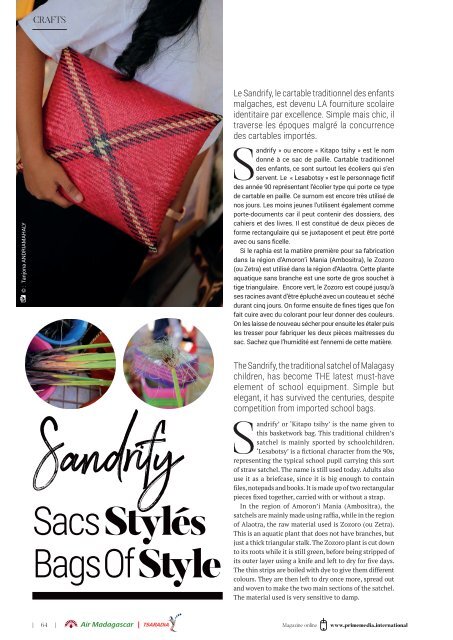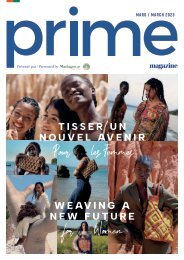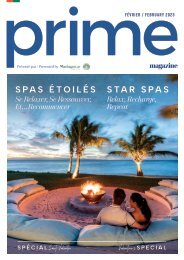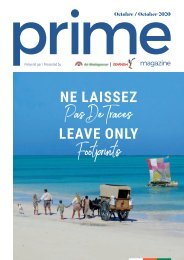Prime Magazine November 2019
You also want an ePaper? Increase the reach of your titles
YUMPU automatically turns print PDFs into web optimized ePapers that Google loves.
CRAFTS<br />
Le Sandrify, le cartable traditionnel des enfants<br />
malgaches, est devenu LA fourniture scolaire<br />
identitaire par excellence. Simple mais chic, il<br />
traverse les époques malgré la concurrence<br />
des cartables importés.<br />
© : Tanjona ANDRIAMAHALY<br />
S<br />
andrify » ou encore « Kitapo tsihy » est le nom<br />
donné à ce sac de paille. Cartable traditionnel<br />
des enfants, ce sont surtout les écoliers qui s’en<br />
servent. Le « Lesabotsy » est le personnage fictif<br />
des année 90 représentant l'écolier type qui porte ce type<br />
de cartable en paille. Ce surnom est encore très utilisé de<br />
nos jours. Les moins jeunes l’utilisent également comme<br />
porte-documents car il peut contenir des dossiers, des<br />
cahiers et des livres. Il est constitué de deux pièces de<br />
forme rectangulaire qui se juxtaposent et peut être porté<br />
avec ou sans ficelle.<br />
Si le raphia est la matière première pour sa fabrication<br />
dans la région d'Amoron’i Mania (Ambositra), le Zozoro<br />
(ou Zetra) est utilisé dans la région d'Alaotra. Cette plante<br />
aquatique sans branche est une sorte de gros souchet à<br />
tige triangulaire. Encore vert, le Zozoro est coupé jusqu’à<br />
ses racines avant d’être épluché avec un couteau et séché<br />
durant cinq jours. On forme ensuite de fines tiges que l'on<br />
fait cuire avec du colorant pour leur donner des couleurs.<br />
On les laisse de nouveau sécher pour ensuite les étaler puis<br />
les tresser pour fabriquer les deux pièces maîtresses du<br />
sac. Sachez que l’humidité est l’ennemi de cette matière.<br />
Sandrify<br />
Sacs Stylés<br />
Bags Of Style<br />
The Sandrify, the traditional satchel of Malagasy<br />
children, has become THE latest must-have<br />
element of school equipment. Simple but<br />
elegant, it has survived the centuries, despite<br />
competition from imported school bags.<br />
Sandrify’ or ‘Kitapo tsihy’ is the name given to<br />
this basketwork bag. This traditional children’s<br />
satchel is mainly sported by schoolchildren.<br />
‘Lesabotsy’ is a fictional character from the 90s,<br />
representing the typical school pupil carrying this sort<br />
of straw satchel. The name is still used today. Adults also<br />
use it as a briefcase, since it is big enough to contain<br />
files, notepads and books. It is made up of two rectangular<br />
pieces fixed together, carried with or without a strap.<br />
In the region of Amoron’i Mania (Ambositra), the<br />
satchels are mainly made using raffia, while in the region<br />
of Alaotra, the raw material used is Zozoro (ou Zetra).<br />
This is an aquatic plant that does not have branches, but<br />
just a thick triangular stalk. The Zozoro plant is cut down<br />
to its roots while it is still green, before being stripped of<br />
its outer layer using a knife and left to dry for five days.<br />
The thin strips are boiled with dye to give them different<br />
colours. They are then left to dry once more, spread out<br />
and woven to make the two main sections of the satchel.<br />
The material used is very sensitive to damp.<br />
| 64 | <strong>Magazine</strong> online www.primemedia.international

















